The Lewis Hillbillies
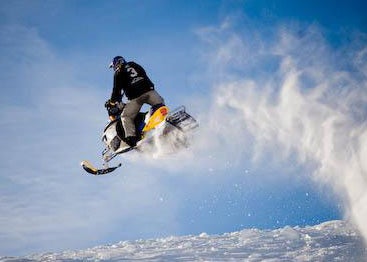
Mountain region in western Newfoundland has such great snowmobiling it has its own following
After skimming across the same river for the second time in less than two minutes, I jokingly asked another of our 16 member group how many more times we had to cross open water.
“Three,” was the response. I couldn’t tell if he was smiling under his helmet.
“Why?” I asked.
“Because that’s the trail.”
And so began the first day of the Big Trip, the annual pilgrimage of the Lewis Hillbillies, so named because they ride almost exclusively in the Lewis Hills located on the west coast of Newfoundland, Canada.
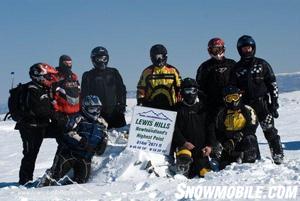 The Lewis Hillbillies have placed a sign at the Roof of the Newf, some 814 meters above sea level. Getting your photo taken with the sign is becoming popular with locals and visitors alike.
The Lewis Hillbillies have placed a sign at the Roof of the Newf, some 814 meters above sea level. Getting your photo taken with the sign is becoming popular with locals and visitors alike.
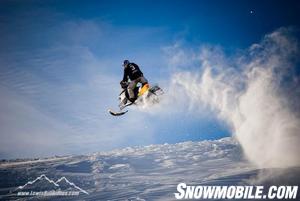 There are lots of natural drops and jumps for the more adventurous riders.
There are lots of natural drops and jumps for the more adventurous riders.
Five times as old as the Rockies, the Lewis Hills are home to the province’s highest point at 814 meters, or 2,670 feet. The elevation of these hills (which by most definitions are technically mountains) may not sound impressive when compared to parts of the Canadian Shield, but the ease of access to these hills from the region’s groomed trail network, and the overabundance of great backcountry and mountain riding rival anything the Rockies have to offer.
The town of Stephenville, Nfld. (pop. 7,000) serves as a perfect base of operations. Many of the town’s hotels feature direct access to the groomed trails, and a 20-mile ride on the well marked trail system takes you to the foot of the Lewis Hills.
This group known as the Lewis Hillbillies was founded in 2002 when two riding buddies—Justin House and Grant Dicks—created a website to post photos of their rides in order to share them with family and friends.
“We began to get a lot of positive feedback about it, especially from our friends who had moved away, but still loved to see pictures of the back country here in western Newfoundland,” says House.
Since then, the site has grown to include 1,400 registered members from all over North America, while the Hillbilly homepage averages over 250,000 hits per year. And it’s still growing.
We finish our fifth crossing of the appropriately named Serpentine River, and one-by-one we proceed up a short, but very steep incline. As I begin my approach, I notice one of the Hillbillies is holding a camera. I hit the throttle in anticipation of a photo fit for the main page of Snowmobile.com, or magazine cover, but the last four feet of the incline are completely vertical, and I shoot high into the air, falling off the sled just before it plummets back to earth. Luckily, the snow is soft and plentiful. Luckier still, the photographer pressed the shutter just as I was coming off the lip. The second photo in the sequence is of me with my arm in the air signaling to those below that I am okay… slightly embarrassed, but with no photographic evidence of my blunder to share with the other Hillbillies.
Normally, my antics would have been captured on video, but the Hillbillies’ resident camera operator, Mike McCarthy (aka Kyody), was unable to make this trip. I’m somewhat grateful, but am told that if he had been there, I may have made the next Lewis Hillbillies video.
The Hillbillies, in fact, have made several videos. These too, started quite innocently with their first release, Lewis Hillbillies (a 17 minute collection of clips set to music), being created as a way to share snippets of video with friends. The lone burnt CD became extremely popular with locals and House received so many requests for it that he eventually had to place copies at a local video shop for people to rent or purchase.
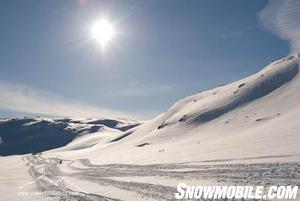 The Lewis Hills seem to go on forever. However, the entire area is contained within 80 square miles.
The Lewis Hills seem to go on forever. However, the entire area is contained within 80 square miles.Subsequent videos have gotten much better in terms of quality, but their style is anything but mainstream (you won’t find many ramps here). There’s still plenty of natural jumps, drops and boondocking, but there’s also an abundance of humor and a great sampling of Newfoundland culture.
“We don’t do this to make money,” says House. “If we did, we would have been bankrupt after releasing The Western Front (their first professionally produced CD and the second of the series). The time it takes to film, compile the footage and edit together a video is ridiculous. But as the years go by we keep getting better at both riding and creating these films. I know it’s a cliche, but we are only doing this for the love of it.”
And apparently a lot more people love it too. The ‘official’ Hillbilly website has been online only since the spring of 2004, and it already has received 600,000 visitors.
Only 16 of the site’s members are on this year’s Big Trip, and after I remount my 600 Renegade, we all make our way to a canyon known as Wheeler’s Gulch.
The climb out of the gulch is tricky, but we manage with only a few delays as several sleds get stuck.
At the top, I look across at the expanse of white. It seems as if this territory goes on forever. However, the Lewis Hills are contained within an area of approximately only 80 square miles. Proximity to the Gulf of St. Lawrence results in plenty of lake effect snow, with an average annual snowfall of about 17 feet. The typical riding season begins early December and ends in late May (the final ride for the Hillbillies last year was June 4).
“If you were to probe some of the valleys and hills, I’d say you’d find there’s about 20 feet (of snow) or more in places,” says House. “But the higher peaks can be windswept to the point where there is barely enough snow to ride on. The riding season for an average snowmobiler—somebody who rides only on the groomed trails—is from mid December to early April, however we use a lot of cross-country routes that allow us to access the hills as late as June.”
We are riding on Feb. 7 and will spend the next three days tearing up as much of this 80 mile square as possible. Powder is plentiful, but hidden rocks make themselves known on some of the windswept slopes. There are no serious incidents, but by day four I notice my right A-arm protector and skid plate are both hanging off my sled.
Even though there are the four days that make up the Big Trip, I ride the Lewis Hills during the first two only. Day three is overcast with heavy snow and poor visibility making the terrain appear flat. There are many holes and crevasses in these hills that can swallow a sled and rider, so a gray, flat day is not ideal for riding here. Instead, I spend the third day trail riding with a smaller group. The rides are short and at a relaxed pace—perfect to rest tired arms and legs.
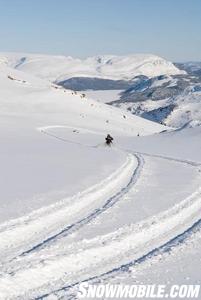 Day four sees a return of great weather as morning greets us with sunshine, blue skies and fresh powder. By now many of the original 16 have returned to their everyday lives, longing for the time when they can get back and ride these hills (which for most will be the following weekend). I spend that fourth morning in an area known as Blue Hill, riding with a couple of friends and a few novices who made their way in the night before. At last, I am among the better riders in the group.
Day four sees a return of great weather as morning greets us with sunshine, blue skies and fresh powder. By now many of the original 16 have returned to their everyday lives, longing for the time when they can get back and ride these hills (which for most will be the following weekend). I spend that fourth morning in an area known as Blue Hill, riding with a couple of friends and a few novices who made their way in the night before. At last, I am among the better riders in the group.
I’m surprised that during the entire four days I only see a handful of other snowmobilers in the Lewis Hills and on the groomed trails. This area is truly still one of snowmobiling’s best kept secrets… but for how long?
“We have gotten a fair bit of exposure recently,” says House, citing the group’s media coverage. “The exposure was due to a lot of hard work, pushing what we have here. We are proud to think that we’ve managed to bring a lot of snowmobile tourism to the Stephenville and Corner Brook areas. Historically, snowmobilers flocked to the Gros Morne aea (a UNESCO World Heritage Site) because of the terrain they have there. Little did people know that the Lewis Hills has the same terrain, but it’s accessible in a much shorter distance, by groomed trails, allowing the departure to be from communities with all the amenities.”
With international airports in Stephenville and Deer Lake (1.5 hours from Stephenville) and a twice-per-day ferry service from Nova Scotia to Port aux Basques (two hours from Stephenville), there’s no reason not to book your winter (or spring) trip to western Newfoundland.
Who knows… you just might meet a Hillbilly there.



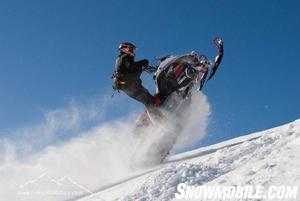
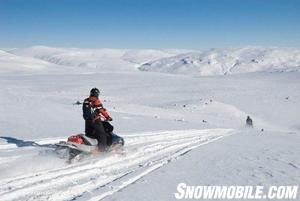
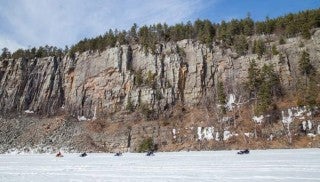
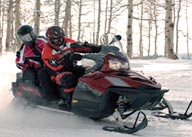
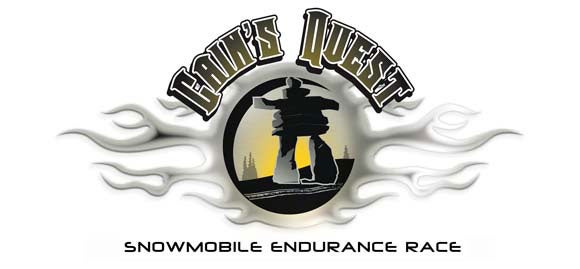


 Your Privacy Choices
Your Privacy Choices